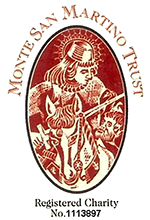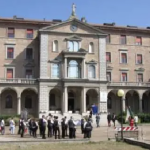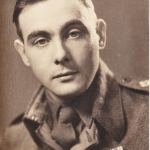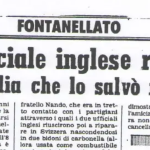Summary of PG Williams
Short account written by Major General (retired) PG Williams (son of Toots Williams) of his visit back to Fontenallato in Italy in September 2018. The visit commemorated the 75th anniversary of the Italian Armistice of 1943 and the mass breakout of Allied POWs that occurred at Campo P.G.49 at that time. This piece constitutes the third part of the story of the escape saga of the author’s father, Colonel Toots Williams (1920-2012) of the Duke of Cornwall’s Light Infantry (DCLI). Part 1 was titled ‘A Long Walk Back’; Toots’ return visit to Italy in 2008 constituted ‘A Long Walk Back – Part Two’; and this piece constitutes the third part of that story.
The full story follows, in two versions. The version in the first window below is the original scanned version of the story. In the second window below is the transcribed version in plain text.
[Digital Page 1]
‘A LONG WALK BACK’ – PART THREE (1)
NOTES ON THE 75th ANNIVERSARY VISIT TO FONTENALLATO TO MARK THE ITALIAN ARMISTICE AND THE MASS BREAKOUT BY ALLIED PRISONERS OF WAR FROM CAMPO P.G. 49
By Major General (retired) P G Williams CMG [Commander of the Order of St. Michael and St. George] OBE [Order of the British Empire]
From Friday 7th to Sunday 9th September 2018 a group of about 90 visitors visited Fontanellato, a town in the Emilia-Romagna area about 15 km from Parma, in order to celebrate the events that occurred there at the time of the Italian Armistice on 9th September 1943, when Italy switched from the Axis to the Allied side and the 600 or so POWs held in Campo P.G. 49 in Fontanellato escaped en masse.
The visit programme was organised by Fontanellato town authorities, led by Mayor Francesco Trivelloni. On the British side, the preparations and execution of the programme were flawlessly managed by the committee of the Monte San Martino Trust (MSMT), led by its President, Sir Nicholas Young, and very ably supported by John Simkins and Christine English, all of whom were the children of POWs in Italy.
[Photograph with caption]: Rocca Sanvitale – the castle in the centre of Fontanellato.
MSMT was founded in 1989 by one of the escapers, Keith Killby, with the aim of ensuring that the bravery and generosity of the many Italians who had risked their lives to help these Allied servicemen, whether escapers or evaders, was not forgotten. Annually MSMT issues bursaries to the grandchildren of those who helped the Allied personnel; the recipients visit England to study English. In 2018 a total of 39 Italian students, aged 18-25, will have taken advantage of these bursary opportunities.
The majority of the visitors to Fontanellato were the children, grandchildren and other relatives of the Allied POWs who had been held in the town from April 1943 onwards; one visitor represented the Escape Lines Memorial Society and the remaining seven guests were a delegation from the Wells Town Twinning committee.
[Footnote] (1) The escape saga of my father, Colonel Toots Williams (1920-2012) of the Duke of Cornwall’s Light Infantry (DCLI) was produced under the title ‘A Long Walk Back’; his return visit to Italy in 2008 constituted ‘A Long Walk Back – Part Two’. Hence this piece constitutes the third part of his story.
[Digital Page 2]
[Photograph with caption]: Frank Unwin and other MSMT members.
One POW escaper, the 98-year old Frank Unwin, also joined the group, along with his son and daughter-in-law; Frank had served in the Royal Artillery and was a prisoner in Campo P.G. 82 in Laterina and then in Stalag XIA near Altengrabow. Most of the group had come from the United Kingdom, but other visitors had travelled from Canada, New Zealand, South Africa and Seattle in the United States. Two Kiwis had even travelled their escaping relatives’ journey in reverse, covering some 800 km on mountain bikes from where they had crossed the Allied front line back to the POW camp in Fontanellato.
The town’s extraordinary hospitality started with a ‘meet and greet’ supper in a community hall, where delicious Parma ham, salami, local cheese, bread and desserts were served and were washed down with generous quantities of local wine; this was a pattern that was repeated on numerous occasions over the next 48 hours. During the welcoming speeches everyone present was invited to send a very loud ‘Three Cheers’ via the magic of the mobile telephone to Keith Killby, the MSMT’s 102-year old founder, who had been unable to travel to Italy with us.
After the supper we all moved on to Fontanellato’s delightful 18th century town theatre, where for about 90 minutes we were entertained by a soprano and a tenor, accompanied by an excellent brass quintet, as they spoiled us with extracts from Aida, Traviata, Il Trovatore and other operatic gems. The evening was pleasantly warm and so through the open side windows of the theatre wafted the sounds of the town’s nightlife, reminding us that this cultural experience was closely connected with everyday life in Italy and was not just for an elite audience.
As the concert came to an end amid a clamour for encores, the MSMT President, Nick Young, suddenly appeared on stage and passed on the very sad news that Keith Killby had died earlier that evening. Apparently the recording of our ‘Three Cheers’ had been played to him with which he had decided to let go. Misty-eyed we all stood to pay our respects as the trumpeter played three ‘G’ notes, which had been the signal given on 9th September 1943 for the Fontanellato POWs to break out of the camp and begin their escaping journeys.
[Digital Page 3]
The second day began with everyone meeting up in a car park in central Fontanellato where we were invited to board a bus for the five minute or so journey to the escaping POWs’ first stop on their ‘freedom trail’. Having been dropped off at Cannetolo, near il Podere Roveto, we walked for about 500 metres along a bund (raised bank) above a large irrigation ditch to the copse where the 600 POWs first sought cover from view in a mass ‘lying up area’.
[Photograph with caption]: The irrigation ditch and bund leading to the ‘lying up area’ copse.]
Once we were assembled in the copse an Italian professor, one of the many experts on the Italian assistance to POWs who were also participating in the programme, called upon several members of our group to read short extracts from the diaries of escapers in which they described the confusion of these first moments of freedom.
[Photograph with caption]: showing the scene of one the first of several expert explanations along our walking route.]
[Digital Page 4]
The Italian commandant of Campo P.G. 49, Colonel Vicedomini, had advised the Senior British Officer (SBO), Colonel Hugo De Burgh, to break out en masse and on the morning of 9th September they did just that and marched to the ‘lying up area’ copse. German troops reached the now empty camp several hours later. On discovering that the POWs had flown, they beat up and arrested the commandant and proceeded to trash the camp before driving off. It appeared that there were more important tasks to deal with rather than to start trying to round up escaped POWs.
During the next few days Italian children brought Red Cross parcel items of food that they had salvaged from the camp to the copse and gave them to the escapers, even though the children and their families were very poor. Adult peasant farmers (contadini) also appeared from the surrounding area and gave items of civilian clothing to the escapers in order to help them blend better into the surrounding countryside.
These were the first of countless acts of compassion and generosity that the escapers were to experience, all of which placed their donors at grave risk. The Germans and their local fascist allies offered large rewards (1,800 Lira) for escapers and for those who dared to help them. Those Italian helpers who were arrested routinely faced torture and execution or deportation to concentration camps in Germany, where large numbers of them perished.
[Photograph with caption]: The farmhouse in which Dan Billany and David Dowie sheltered.
Near the initial ‘laying up area’ was a farmhouse where the peacetime novelist and wartime officer in the East Yorkshire Regiment, Dan Billany, and his partner, David Dowie, an officer in the Northumberland Fusiliers, took shelter. While there Billany completed his novel ‘The Cage’ in which he described the difficulties that being gay in a POW camp without any privacy had presented. Before moving on from the farmhouse in October 1943 he entrusted his manuscripts to the family that had sheltered him, intending to recover them after the war. Tragically, both men were to meet unknown fates somewhere, probably near Capistrello, in November 1943 as winter set in in the Apennines. Dan Billany’s novels were published posthumously after the war.
[Digital Page 5]
Our group walk ended after 4 km in the town of Soragno, where we were welcomed by the owner of the town’s fortress palace, Prince Meli Lupi, and we were then given a guided tour around the splendid Rocca Meli Lupi.
[Photograph with caption]: The Rocca Meli Lupi fortress palace in Soragno.
A curious feature of this palace was the Waiting Room in which the frescoes showed powerful biblical heroines killing their menfolk.
[Photograph with caption]: A fresco of Judith beheading Holofernes.
After our trek in the heat of the day and our exposure to images of homicidal women we were delighted to be invited to settle down for a picnic ‘contadini’ meal in the grounds of Soragno’s Museum of Cheese before returning by bus back to Fontanellato at teatime.
[Digital Page 6]
Before leaving Soragno we were taken to the memorial to four partisans who were executed in the heart of the town along the rear wall of the Rocca; the bullet holes have been preserved in order to emphasise the brutal circumstances of their deaths. We received a grim briefing on the risks taken by those who opposed the fascist regime which often retaliated by taking and killing blameless hostages in response to partisan operations.
[Photograph with caption]: Soragno’s memorial to four executed partisans.
Several hours later we found ourselves ‘on parade’ once again, this time gathering in front of Fontanellato’s Rocca Sanvitale fortress, where we enjoyed a guided tour of the town’s museum before settling down for a supper on trestle tables in the castle’s courtyard. Unlike the Rocca Meli Lupi in Soragno which remains in private hands, Fontanellato owns the Rocca Sanvitale and the Mayor was justifiably proud of the restoration work that has already done much to preserve its medieval splendour.
[Photograph with caption]: Supper laid out in the Rocca Sanvitale courtyard.
[Digital Page 7]
A surprise addition to our supper in the courtyard was a van that dispensed gourmet deep-fried vegetable to us all, served in little paper cornets.
[Photograph with caption]: The deep-fried vegetable van about to open for business.
The final day of the 75th Anniversary weekend saw everyone gather once again in front of the Rocca Sanvitale which was to be the start point for our procession through the town of Fontanellato. The Mayor, the Red Cross representative, the MSMT President, the town’s banner and the local ‘Luigi Pini’ brass band formed up in the sunshine and prepared to lead us all through the town, via the war memorial, to the main church, the Santuario Basilica della Beata Vergine del Santo Rosario.
[Photograph with caption]: The Mayor, Hugo De Burgh (son of the SBO [Senior British Officer]) and Nick Young.
[Digital Page 8]
Pretty much exactly as per the programme the band played a medley of appropriate marching tunes in order to get us all into the mood and then it led us off into the town.
[Photograph with caption]: The ‘Luigi Pini’ band opening the proceedings.
What perhaps no one had anticipated was that Sunday was market day and so the whole procession – band, VIPs and over a hundred other participants – had to wend its way through the market stalls, strolling shoppers, pavement coffee drinkers and the rest en route to the town’s war memorial.
[Photograph with caption]: The MSMT procession weaving its way through the bustling market stalls.
[Digital Page 9]
[Photograph with caption]: The wreath laying ceremony at Fontanellato’s War Memorial.
From the war memorial the band led us to the church which was already very full and we waited outside while seats were found for the MSMT visitors in the side chapels near the altar. We then enjoyed the majesty of the Mass, during which the lessons were read in English by members of our group and were then repeated in Italian by local readers. It was a moving experience in glorious surroundings.
[Photograph with caption]: A nun selling colour coordinated produce outside the church.
[Digital Page 10]
After the church service it was time to move on to the final phase of the commemorative programme: the ceremony at the former Campo P.G. 49 building, which is now the Cardinal Ferrari Centre for people with mental impairments.
[Photograph with caption]: The procession arriving at the front of the former Campo P.G. 49
Once the Mayor and the MSMT President had reached the main steps of the magnificent former orphanage (only completed in 1939), the band played both the British and the Italian national anthems, a wreath was laid at the feet of Cardinal Ferrari’s statue and the final formal speeches were made by both parties.
[Photograph with caption]: The wreath that was laid in the former Campo P.G. 49
[Digital Page 11]
Although there are numerous exhibits that show how it was designed and equipped to work as an orphanage, the only evidence inside the Cardinal Ferrari Centre that attests to its role as a POW camp is a marble plaque in Italian on the wall of a ground floor corridor.
[Photograph with caption]: The memorial plaque to Campo P.G. 49 inside the Cardinal Ferrari Centre.
The final event of the programme was an informal light lunch held in the shade behind the Cardinal Ferrari Centre and so pretty much in the area used by the POWs for sports. There the Mayor and his principal assistant were given gifts in thanks for the overwhelmingly generous welcome that Fontanellato had extended to its MSMT, Escape Lines Memorial Society and Wells Twinning guests.
[Photograph with caption]: Mayor Francesco Trivelloni accepting one of his well deserved gifts.
[Digital Page 12]
Also present at the ceremony and lunch at the Cardinal Ferrari Centre was a most remarkable character, the 94-year old former partisan and escape lines operator, Signor Francesco Gnecchi-Ruscone, accompanied by his daughter, Alessandra. A multi-lingual retired architect, he recalled with extraordinary clarity his time aiding Allied servicemen, his arrest, torture and imprisonment by the Germans and his unexpected release from captivity in March 1945.
[Photograph with caption]: Signor Francesco Gnecchi-Ruscone.
Perhaps even more extraordinary than his account of his wartime adventures was a family coincidence that emerged unexpectedly while my brother-in-law, James Anderson, and I were talking to him. We explained that at that table we were all members of the families of officers who had served in the DCLI [The Duke of Cornwall’s Light Infantry] and were incarcerated in Campo P.G. 49.
The word ‘Cornwall’ immediately caused him to declare that he knew Cornwall, with which he reached into his briefcase and produced an A4 ring-binder. “I am writing a book of sorts to keep my mind active”, he declared, “In fact, here is an image of a watercolour that I painted in Cornwall about 15 or so years ago”. The picture showed sheep grazing on a moorland pasture.
“So, where did you paint it?” I asked. “Cabilla Manor” was his immediate response. “But that’s my twin sister’s house!” I said, with which he turned to the next page in his file in which he described in Italian how he had indeed stayed at Cabilla with Robin and Louella Hanbury-Tenison. It is indeed a very small world and, as my father often said: “The world is full of coincidences, but if you don’t talk to people you’ll never find them”.
The commemorative events in Fontanellato on the Sunday had proved to be the perfect ending to a most memorable and joyful weekend in the company of so many delightful people, all of whom shared the privilege of being connected to former POWs in Italy in the Second World War and whose support for the aims of the Monte San Martino Trust has been further strengthened by this wonderful experience.
[Digital Page 13]
AFTERNOTE
Having been amazed that Francesco Gnecchi-Ruscone had stayed with my sister and brother-in-law at Cabilla, I contacted Louella to see if she recalled his visit. She replied that not only did she remember Francesco’s time with them in August 2005, but that a picture that he gave her still hangs in the dining room at Cabilla and much appreciated. What a small world it really is!
[Photograph with caption]: Francesco Gnecchi-Ruscone’s painting at Cabilla.
[Photograph with caption]: The author and James and Rosie Anderson – Fontanellato 2018
[Digital Page 14]
FONTANELLATO BIBLIOGRAPHY
Supplied by MSMT Supporter Julia MacKenzie
Bell, Ian, And Strength Was Given. Tynedale & Panda Publishing, Lowestoft, 1989
Bell, Ian, No Place to Hide. Minerva Press, London, 1998
Billany, Dan, in collaboration with David Dowie, The Cage. Longmans, 1949
Billany, Dan, The Trap. Faber & Faber, 1950 [novel]
Carver, Tom, Where the Hell Have You Been? Short Books, 2009 [by son of Richard Carver]
Davies, Tony, When the Moon Rises. Leo Cooper, 1973
English, Ian, Assisted Passage. Privately published, 1994
English, Ian (ed.), Home by Christmas? Privately published, 1997; reprinted 2017
Flowerdew, Douglas, Finding the Way: Wartime Adventures in Italy 1942-43. Privately published, 1988 (includes a memoir by Drew Bethell)
Gibbs, Denis L.A., Apennine Journey. Privately published, n.d.
Gilbert, Michael, Death in Captivity. Hodder & Stoughton, 1952 [novel]
Graham, D.S., Escapes and Evasions of an Obstinate Bastard. Privately published, 2000
Hood, Stuart, Pebbles From My Skull. Hutchinson, 1963; reprinted with a new afterword, Carcanet, 1985
Kindersley, Philip, For You the War is Over. Midas Books, Tunbridge Wells, 1983
Mann, Ronald, Moving the Mountain. Aldersgate Productions, 1995
Mather, Carol, When the Grass Stops Growing: A War Memoir. Leo Cooper, 1997
Newby, Eric, Love and War in the Apennines. Hodder & Stoughton. 1971
Newby, Wanda, Peace and War: Growing up in Fascist Italy. Collins, 1991
Reeves, Valerie and Valerie Showan, Dan Billany. Hull’s Lost Hero. Kingston Press, Hull, 1999 [biography of Dan Billany]
Ross, Michael, From Liguria with Love: Capture, Imprisonment and Escape in Wartime Italy. Minerva Press, 1997
Woods, Rex, One Man’s Desert: The Story of Capi. Pip Gardner, VC, [Victoria Cross] MC. [Military Cross] William Kimber, 1986



